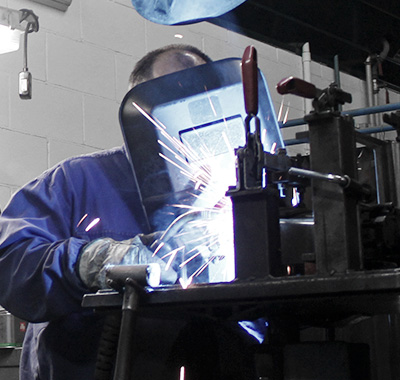In industrial metal welding jobs where our robots, cannot reach, Benseny professional welders trained in ASME 9 and EN 15085-CL3. standards arrive.
At Benseny we use different types of welding, depending on the needs of each part or product to be manufactured.
The types of MIG, MAG and TIG Welding are the most used.
MIG, MAG and TIG metal welding: Applications and Uses
Welding is a fundamental process in the industry, and there are various methods to join materials safely and lastingly. Three of the most used methods are MIG, MAG and TIG welding. Each of them has particular characteristics that make them suitable for different applications and materials. In this article, we will explore these types of welding and their common uses.
MIG (Metal Inert Gas) metal welding:
MIG welding, also known as inert gas welding, is a process that uses a continuous electrode and a shielding gas to join metals. In this method, the electrode is automatically fed through a welding gun, while an inert gas, such as argon or a mixture of argon and carbon dioxide, is used to protect the welding area from atmospheric contamination.
MIG welding is characterized by its speed and ease of use, making it ideal for industrial and mass manufacturing applications. It is commonly used for welding carbon steel, stainless steel and aluminum. It is suitable for jobs that require high productivity, such as the manufacturing of automobile bodies, metal structures and pipes.
MAG (Metal Active Gas) metal welding:
MAG welding, also known as active gas welding, is similar to MIG welding in terms of the process and equipment used. However, instead of using an inert gas, an active gas, such as a mixture of carbon dioxide and argon, is used to provide protection and stability to the welding arc.
MAG welding is primarily used in carbon steel applications, where higher penetration and welding speed are required. It is widely used in the manufacture of heavy machinery, shipbuilding, bridges and metal structures. MAG welding can also be used to weld stainless steel and other metals, depending on the composition of the gas mixture used.
TIG (Tungsten Inert Gas) metal welding:
TIG welding, also known as tungsten inert gas welding, is a process that uses a non-consumable tungsten electrode and an inert gas to weld metals. Unlike MIG and MAG welding, TIG welding does not use a continuous electrode, but instead requires the welder to manually supply filler metal if necessary.
TIG welding stands out for its precision, control and the high quality of the welded joints. It is widely used in applications that require high-quality welding, such as the aerospace industry, medical equipment manufacturing, food industry, and jewelry manufacturing. TIG welding is compatible with a wide range of materials, including stainless steel, aluminum, copper, titanium and specialty alloys.
Conclusion:
MIG, MAG and TIG welding methods are widely used in the industry due to their different characteristics and applications. MIG welding is fast and versatile, ideal for industrial applications on carbon steel, stainless steel and aluminum. MAG welding provides greater penetration and is used in carbon steel applications, while TIG welding offers high quality and precision on a wide range of materials.
Choosing the right metal welding method depends on the materials, project specifications, and required quality standards. At Benseny we are experienced welding professionals and we select the appropriate method and execute it safely and efficiently.

